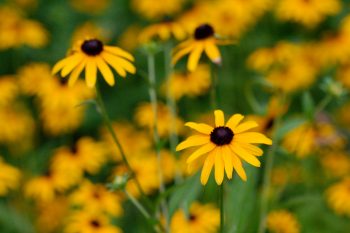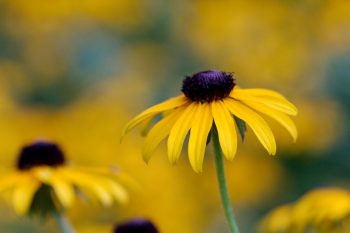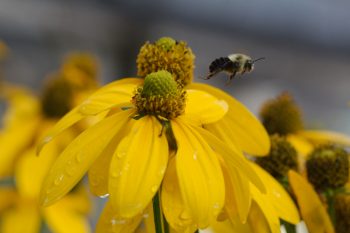The skippers are a constant source of attraction pretty much all summer and into the fall in our yard. They may have their favorites but they are generally everywhere, from the black-eye Susans (Rudbekia) as seen here, to the Verbena bonariensis, the mountain mint (Pycnanthemum muticum), and the Buddleia. They are everywhere and it pretty huge numbers. If you walk along the edge of the black-eyed Susans, they fly off en masse and alight again, further along or behind you. It’s enjoyable just to watch them flitting about, sometimes two or even three on a flower, but not usually for long, as they are so often on the move.
Tagged With: Rudbeckia
Skipper on Rudbekia
Black-eyed Susan
The 25 or so Rudbekia species are all native to North America and Rudbeckia hirta is the state flower of Maryland. We actually have two related varieties of black-eyed Susans in our yard and I don’t know if they are different species or different varieties of the same species. This is by far the more aggressive of the two and left to itself would probably take over the entire yard. In fact, even with some efforts to contain it, it’s taking over the entire yard. On the other hand, there isn’t a lot else blooming right now and if you look into our back yard, it’s filled with yellow, so I can’t really complain. This year, the garden has pretty much had to find for itself. Hopefully we’ll be able to do something with it next year.
Rudbekia
Here’s another photo of the black-eyed Susans in our back yard. After work today I sat in the back yard for a while. I decided it was time I cut my hair so I got the clippers out and did it. It was very hot and the hair stuck all over me but it’s done. While I was sitting after getting my hair cut, I enjoyed the black-eyed Susans that surround our patio. They have gotten somewhat out of control but they are lovely and if anything is going to go wild, it might as well be pretty. This is a time of the summer when there isn’t a lot else in bloom and the Rudbekia are quite welcome. Maybe next year we’ll have time to fight them back a little but for now, we’ll just enjoy their abundance.
Honey Bee on Rudbekia
As I’ve mentioned before, the garden is somewhat overrun with Rudbekia (a.k.a. black-eyed Susan) flowers. The bees don’t mind. There are, actually, other things in bloom, but none nearly as obvious. The mountain mint (Pycnanthemum muticum), for instance, is very popular with the bees of all sorts. But their flowers are much less showy. This afternoon I took a bunch of pictures of various bees on the black-eye Susan flowers. This one is a western honey bee, Apis mellifera. Contrary to popular belief, they are in no real danger of all dying out. You can, to a large degree, thank capitalism for that, although I think the danger was considerably exagerated, in any case.
Black-eyed Susan
I took some pictures of skippers on black-eyed Susan flowers this evening. I also got a few decent shots of a little leaf hopper, which I haven’t identified. They are quite small and this one was probably only about 5mm long. There are about 3,000 described species in north America along and it is estimated that there are more than 100,000 species worldwide, with less than a quarter actually having been described. I decided to post this picture, instead of one with an insect, just because I like the shallow depth of field on the yellow petals of the black-eyed Susan.
Black-eyed Susan
It was a pretty normal, overcast, somewhat dreary, winter’s day today. No rain or snow but cool and damp. The ground is completely saturated and there is some leftover snow scattered around. It’s warmer than it’s been and forecast to be in the 60s this week. This is the remains of a black-eyed Susan (Rudbeckia species). We leave them through the winter for the birds, although most of them don’t get eaten by the spring. Sometimes we’ll see goldfinches (Spinus tristis) or dark-eyed juncos (Junco hyemalis up in them, but food is never really scarce around here.
Black-eyed Susans
I’ve posted pictures that have Black-eyed Susans in them but today’s photo is just of them. To say we have a few is a bit of an understatement. The reality is that we have let them run riot and there are a lot of them in the back yard. They add so much color that we don’t really mind, especially around the patio. We’ve managed to keep one large and one small walkway through them, so we can get out into the yard. They are pretty popular with the pollinators, attracting bees, flies, moths, and butterflies. One interesting thing about them is the photos I take always look bluer than they look in real life and I have to correct for that. On the other hand, the leaves really do have a fair amount of blue in their green.
Black-eyed Susan
The black-eyed Susans in the yard are mostly finished now. The petals are drying up and falling off. Soon there will be nothing left but the stalks and seed heads. We generally leave those for the birds to eat during the winter. They seem to be pretty popular with the gold finches, in particular. This isn’t as good a picture as I hoped it would be. It was fairly late in the day and I didn’t bother to get my tripod, so I wasn’t able to get the depth of field that I should have. Still, I like the colors quite well. This is what autumn is about.
Rudbeckia Seeds
I took photos of various seeds in the yard this afternoon. First I took pictures of seeds of the Euonymus japonicus. From there I moved on to these Rudbeckia seed heads. I think their form and subtle brown colors. I took photos of blackberry lily Iris domestica fruit, which do have a pretty blackberry-like appearance. I also took a few photos of the tops of Monarda and of the feathery seeds of the Clematis terniflora. None of the photos were wonderful but this one is my favorite. I also took a photo of a robin in the holly tree by the driveway.
Black-eyed Susan
Our yard is pretty heavy on the Rudbeckias, (black-eyed Susan) although we’ve actually gotten rid of a few. You probably wouldn’t notice and it’s going to take a bit more work if we’re actually going to cut back on them noticeably. On the other hand, this time of year, they really are wonderful in their great numbers. The insects like them, although perhaps they aren’t the favorite flower. The skippers in particular are to be found on them and that’s where I usually see transverse flower flies (Eristalis transversa).
The Back Garden
This is a portion of our back garden, which, as you can see, is somewhat dominated by black-eyed Susan flowers at this time of year. They are probably just past their peak but will provide color for a bit longer as they fade from their bright orange to a more rusty, autumnal ochre. You can just make out the hardware cloth ‘fence’ around one of my roses a little to the left of center. By the end of the summer, the three roses should be tall enough that they are safe from rabbits, although there’s not really anything we can do about deer.
Early Autumn
The autumn clematis (Clematis terniflora) is coming into bloom. This is a fairly aggressive vine native to Japan. It can be a little invasive but if you have a largish area to cover, it’s not a terrible choice. It’s flowers are a lovely white and come late in the summer and continue well into the fall. One of it’s common names is sweet autumn virginsbower. We have it growing on the falling down fence at the southwest corner of our house (the southeast corner of our back yard). Cathy is especially fond of it and as long as I’m allowed to keep if confined to that area, I’m happy to let her have some.
Winter
As we pass through the darkest days of the year, it’s good to remember the brighter times that are coming. In the summer, the yard was filled with colors, green, yellow, pink, red, and purple. In the winter most things are brown or grey. But the cycle repeats. The brown seeds grown into green plants that bloom in all the colors of the rainbow. But even the browns can be pretty. I wondered around the yard this afternoon and took a handful of photos, including this of black-eyed Susan seed heads. In a surprisingly short time, the yard will be in bloom again.
Busy As A…
Cathy and I went to Stadler Nursery late this morning. I bought a ninebark (Physocarpus opulifolius) called ‘Fireside’. It has very dark leaves which are a really lovely red early in the year and darken until they are nearly black in the late summer and fall. As usual I also took some flower photos. Getting an insect on the wing is not something I’ve had much success doing but this one turned out pretty well. It’s a common eastern bumble bee (Bombus impatiens) leaving a Rudbeckia ‘Herbstonne’ flower. We have a lot of Rudbeckia in our yard but most of it is one variety that is quite invasive. I wouldn’t mind thinning that out and replacing some with different types and this one is pretty nice.














